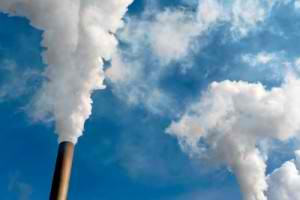Last month, the Energy Information Administration released data showing a strong drop in U.S. carbon dioxide emissions in the first quarter of 2012. With CO2 emissions falling to their lowest levels in 20 years, some expressed optimism that it was representative of a positive long-term shift.
However, as we pointed out, it looks like this drop in America’s “carbon weight” is mostly based on a fad diet consisting of natural gas — a fuel considered the “crack cocaine” of the utility sector — not necessarily on a new, healthy energy diet of efficiency and renewables. (Going even deeper, the EIA figures don’t factor in methane from natural gas, so we still don’t know how much the boom in gas has impacted our overall greenhouse gas emissions).
New data from the EIA backs up concerns that the 2012 drop in CO2 isn’t as big as it seems.
According to the agency’s latest short-term outlook, CO2 emissions in the power sector are set to rise by 2.8 percent in 2013 after declining by 2.3 percent in 2011 and 2.4 percent in 2012. Why? Because natural gas prices are on the upswing, thus reducing gas consumption in the electric power sector and encouraging more consumption of coal:
After declining by 2.3 percent in 2011, fossil fuel emissions are projected to further decline by 2.4 percent in 2012, but this decline is followed by an increase of 2.8 percent in 2013. Petroleum emissions decline in 2012 (1.4 percent) and grow only 0.2 percent in 2013. Natural gas emissions rise by 5.2 percent and 0.1 percent in 2012 and 2013, respectively. Coal emissions decline 8.9 percent in 2012, but their projected rise of 8.5 percent in 2013 is spurred by a 19‐percent increase in the cost of natural gas for electricity while the cost of coal for power generation stays flat.
The share of total generation fueled by natural gas during the first half of 2012 averaged 30.4 percent compared with 22.3 percent during the same period last year. This increase in fuel share was driven by a cost of natural gas that was very low relative to the cost of coal. However, in June, the average Henry Hub natural gas spot price surpassed the average spot price for Central Appalachian coal for the first time since October 2011, indicating that the recent trend of substituting coal‐fired generation with natural‐gas‐fired generation may be slowing and will likely reverse. In light of the data indicating that power generators have recently been more responsive to changes in relative fuel costs, EIA has revised its projections for the generation fuel mix during 2013. EIA now expects that the higher natural gas prices next year will lead to a 9.5‐percent decline in natural gas‐fired generation while coal‐fired generation increases by 9.3 percent.
EIA expects non-hydro renewables to grow in 2013, but only by about 4.1 percent.
The impact of rising natural gas prices is the really interesting story here. Even with a modest increase in average gas prices from $2.65 per MMBtu to $3.34 per MMBtu — we see a fairly substantial shift back toward coal consumption. And with some experts reporting that we only have between 10-20 years of abundant natural gas (not 100, as the industry claims), a much steeper price increase is probable, which could possibly fuel even greater increases in coal burning.
At the same time, rising gas prices will also take some of the pressure off renewables that compete directly with the resource. However, as this data shows, it may also encourage more coal generation in the short and mid term. We’ve made progress in reducing emissions from fossil fuels in the electric power sector, but it’s still uncertain how steady those decreases will prove.
This article was originally published by Climate Progress. Republished with permission.











